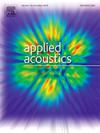Passive source localization by two hydrophones in direct arrival zone and shadow zone
IF 3.4
2区 物理与天体物理
Q1 ACOUSTICS
引用次数: 0
Abstract
A broadband source localization method based on two kinds of multipath time delays using dual vertical hydrophones suitable for both direct arrival zone (DAZ) and shadow zone (SZ) in deep water is presented. We analyze the multipath time delays in the DAZ and SZ for sound source near the surface, which are related to source depth and range. Thus, source position can be estimated using these time delays. However, there is currently a problem of source position ambiguity in the previous localization methods, especially misjudgment of sound zones. Our approach addresses the above issues from two perspectives. On the one hand, two types of time delays are used for localization to avoid the ambiguous position results caused by using a single time delay. On the other hand, we use dual hydrophones to overcome the problem of misjudgment in sound zones. Four positioning results can be obtained by locating the signals received by two vertical hydrophones using time delays calculated in the DAZ and SZ, and the average of the two results with the highest similarity is the accurate source position. The simulation results and the experimental data indicate that the method has good localization performance and robustness in the both DAZ and SZ.
求助全文
约1分钟内获得全文
求助全文
来源期刊

Applied Acoustics
物理-声学
CiteScore
7.40
自引率
11.80%
发文量
618
审稿时长
7.5 months
期刊介绍:
Since its launch in 1968, Applied Acoustics has been publishing high quality research papers providing state-of-the-art coverage of research findings for engineers and scientists involved in applications of acoustics in the widest sense.
Applied Acoustics looks not only at recent developments in the understanding of acoustics but also at ways of exploiting that understanding. The Journal aims to encourage the exchange of practical experience through publication and in so doing creates a fund of technological information that can be used for solving related problems. The presentation of information in graphical or tabular form is especially encouraged. If a report of a mathematical development is a necessary part of a paper it is important to ensure that it is there only as an integral part of a practical solution to a problem and is supported by data. Applied Acoustics encourages the exchange of practical experience in the following ways: • Complete Papers • Short Technical Notes • Review Articles; and thereby provides a wealth of technological information that can be used to solve related problems.
Manuscripts that address all fields of applications of acoustics ranging from medicine and NDT to the environment and buildings are welcome.
 求助内容:
求助内容: 应助结果提醒方式:
应助结果提醒方式:


